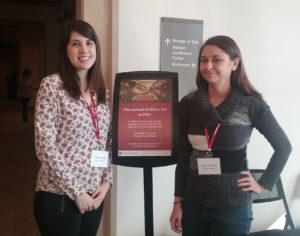 In December of last year, we met some amazing animal advocates at the Animal Welfare Act at 50 Conference, held at the Harvard Law School. This event was a great opportunity to stay up-to-date with what’s happening in the world of animal law, so that we can use that knowledge to help protect cats’ lives. The conference brought attendees together with speakers experienced with the Act, 50 years after the Animal Welfare Act was first passed in 1966. The topics of the conference varied, from welfare standards, to the interaction of the Act with other laws, to litigation and enforcement issues.
In December of last year, we met some amazing animal advocates at the Animal Welfare Act at 50 Conference, held at the Harvard Law School. This event was a great opportunity to stay up-to-date with what’s happening in the world of animal law, so that we can use that knowledge to help protect cats’ lives. The conference brought attendees together with speakers experienced with the Act, 50 years after the Animal Welfare Act was first passed in 1966. The topics of the conference varied, from welfare standards, to the interaction of the Act with other laws, to litigation and enforcement issues.
The Animal Welfare Act sets out minimum standards of care for a narrow number of species sold and transported commercially, used in research, or exhibited to the public. Additionally, the Act only applies to certain types of people who deal with animals, such as dealers who sell animals for profit and exhibitors who exhibit animals in zoos, circuses, or the like. It excludes several species, including birds, rats, livestock and poultry used for food or fiber, and does not cover animal shelters.
The purpose of the conference was to look at what the Act really does, and, perhaps more importantly, where it needs to go after 50 years of implementation. Every presentation touched on this and ultimately asked the question: Does the Act truly provide “welfare” to the animals it purports to regulate? The consensus was a resounding no.
The Act falls short in many ways. Although it seeks to ensure animals are kept and treated in a humane manner, so very many are not. Painful procedures are still tested on animals; exotic species are kept in heinous roadside zoos; and, millions of livestock and poultry continue to be unprotected and suffer.
But it’s not all doom and gloom. We have come a long way in terms of the way we treat animals since 1966. More and more people are acknowledging the rights of animals and believe they deserve increased protection. This is particularly the case for community cats. When Alley Cat Allies first began in 1990, very few communities were engaged in Trap-Neuter-Return. Today, over 600 communities have TNR ordinances and many, many more have active TNR programs.
There is so much more that can be done for the humane treatment of animals. We at Alley Cat Allies strive to do more each year and will continue to tirelessly advocate on behalf of cats and all other animals.

![]()
Molly Armus
Staff Attorney
Alley Cat Allies’ Humane Law & Policy Division


Misty Christo
Staff Attorney
Alley Cat Allies’ Humane Law & Policy Division

